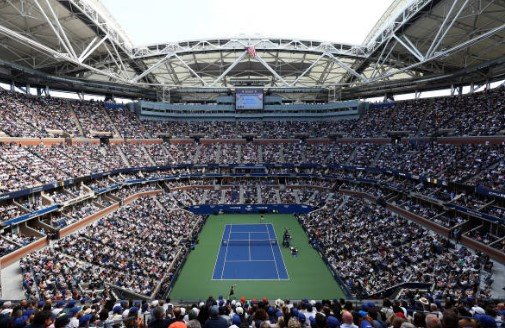With the final Grand Slam upon us, the US open Wildcards have been announced. The whole wildcard system in tennis has long been a topic of debate, and probably no more than in recent weeks.
We’ve had Venus Williams receive a Wildcard at the DC Open, despite not having played a match for roughly 18 months. Just a few weeks earlier, 59 year-old, Bill Ackman, received a doubles Wildcard in Newport, partnering with Jack Sock.
Across every single tournament throughout the year, Wildcards are handed out. For the major events – the Australian Open, French Open, Wimbledon, and US Open – 8 positions are reserved for the discretion of the tournament. These are often given to local talents, returning veterans, or rising stars.
Occasionally, we do get a storyline out of them. Just months ago, we had Loïs Boisson’s remarkable semi-final run at the French Open, displaying exactly what tennis wants from its Wildcard entrants.
However, these moments are outliers in a system that, if we’re being honest, has significant flaws. Data from the 2023, 2024 and 2025 Grand Slams, combined with concerns around equity, make a compelling case for abolishing wildcards at tennis’ most elite tournaments.
The Numbers:
It’s easy to point at the occasional success, as to why Wildcards should remain, but the numbers paint a pretty bleak picture of Wildcard performance.
Across the last 11 Grand Slam events (2023, 2024, and the first 3 of 2025), a total of 176 Wildcards were awarded—88 to men and 88 to women.
Of those 176 Wildcards, 123 players (approximately 68%) exited in the 1st Rd, and another 36 fell in the 2nd. Only 17 advanced to the 3rd Rd. and beyond.
That’s a success rate of less than 10% for what could be loosely considered a “deep run.” Standout performances, like Arthur Cazaux reaching the 4th Rd. at the 2024 Australian Open, or Rinky Hijikata reaching the same point at the US Open a couple of years back, are rare exceptions. The majority of Wildcards produce lopsided matches, bringing minimal value to the event.
et=”_blank” rel=”noopener”>Embed from Getty Images
Grand Slams are the pinnacle of professional tennis, and what all aspiring tennis players aim for when starting out a career in the sport. Entry needs to reflect a player’s ability to compete at this level, earned through the week in-week out grind of the tour.
Wildcards, however, bypass this, taking places away from players ranked roughly 105-112 (give or take depending on withdrawals). Why should a player who’s fought hard to lift their ranking, be overlooked for a ‘local up-and-comer?
The system rewards connections, or sentimentality over consistent performance, eroding the fairness that should be absolute in the most prestigious events on the tour.
Local Bias
The bias toward host nations further tilts the scales. With 4 countries hosting Majors, and reciprocal Wildcards still in play, the data from 2024 and 2025 is telling: The 4 Grand Slam host countries were handed over 75% of the Wildcards.
This isn’t a coincidence; it’s a structural feature of the wildcard system, where organizers prioritize local players, in the name of ‘fan engagement’, or ‘national pride’. While this absolutely has a place at smaller events, which are held all over the globe, it’s problematic on the biggest stage of Grand Slams.
Players from non-hosting nations, no matter how talented, face a systemic disadvantage. A local player from Australia for example, can pretty much set up the first half of the year with a Wildcard into the Australian Open. By losing in the opening round, a player pockets $132,000 (AUD). For someone from another country, that could be 2 or 3 years on the Challenger/ITF Tour. It’s a massive advantage.
Majors Don’t Need Commercial Wildcards
The commercial needs of Grand Slams, aren’t predicated on the field, anywhere near as much as 250 events, or tournaments on the lower tier. Smaller tournaments, like ATP 250 events or the Challenger Tour, can struggle to fill seats and generate local excitement.
In this instance, Wildcards can definitely move the needle somewhat, drawing crowds by featuring a local hero, a returning star, or a young prodigy. Grand Slams, however, face no such challenges.
Tickets for Wimbledon sell out months in advance, the Australian Open has had record crowds flocking through the gates, and television audiences are pretty much guaranteed regardless of who’s playing.
The star power of players like Novak Djokovic, Iga Świątek, or Carlos Alcaraz ensures global attention. Wildcards aren’t needed to sell tickets or boost viewership at these events, so why allocate precious draw spots to players who haven’t proven they can compete at the top echelon?
Redirecting wildcards to lower-tier tournaments would nurture emerging talent and bolster the sport’s grassroots, creating storylines without compromising the Slams’ competitive integrity.
Performance:
Beyond these points, wildcards risk diluting the overall quality of Grand Slam draws. Early-round blowouts can sap the energy from a tournament’s opening days, leaving fans and broadcasters with lackluster matches.
Almost 70% of Wildcards are packing their bags after Rd. 1, and over 90% are out of the tournament by Rd 2, suggesting that many wildcards simply aren’t ready for the main stage. And that’s not their fault. Who would knock back a free entry to a Major?
But these mis-matches don’t just disappoint spectators; they frustrate players who may have been forced to go down the qualifying path due to Wildcard entry slots.
Perhaps it’s no surprise that the majority of ‘deep runs’ in Slams from Wildcards, have come from established players.
- Elina Svitolina’s semi-final at the 2023 Wimbledon event.
- Caroline Wozniacki’s 4th Rd at the 2023 US Open.
- Raducanu’s 4th Rd at Wimbledon, and 3rd Rd performances from Alexei Popyrin, Thanasi Kokkinakis, David Goffin, etc.
(Ironically, the controversy over the US Open 2025’s Wildcard allocations, is that Stan Wawrinka, a former champion, hasn’t been given one).
While we had Lois Boisson set the Roland Garros crowd alight with her semi-final earlier this year, surely that’s not enough to justify the number of early exits?
get=”_blank” rel=”noopener”>Embed from Getty Images
Moreover, the Wildcard selection process can feel muddy, and sometimes political. Decisions sometimes hinge on factors like a player’s marketability, past achievements, or often, relationships with tournament officials, raising questions about fairness.
This isn’t to say wildcards have no place in tennis. They can be invaluable for developing talent and boosting interest at smaller events, where players like a teenage Joao Fonseca, or Australia’s number 1 junior, Emerson Jones, can shine without disrupting a major’s competitive balance.
But at the Grand Slams, the stakes are too high, and the prestige is too great to justify their inclusion. The recent data—where only a handful of the 176 wildcards made a meaningful impact—backs up this point.
Perhaps the solution is to keep 2 Wildcards per Major, held only for players who have given something to the sport, or are returning from injury/maternity leave. That way, we can still have situations like Goran Ivanisevic winning Wimbledon, or Svitolina reminding us all how good she was, before her time off to start a family.
et=”_blank” rel=”noopener”>Embed from Getty Images
We love stories of underdogs against the odds, but those stories won’t become any less exciting for players who have earned their place. It’s time for the Slams to embrace a merit-based system and leave the Wildcards for boosting the smaller events.
The 2025 US Open Wildcards:
Women:
Alyssa Ahn
Caroline Garcia
Talia Gibson
Valerie Glozman
Caty McNally
Clervie Ngounoue
Julieta Pareja
Venus Williams
Men:
Nishesh Basavareddy
Darwin Blanch
Tristan Boyer
Stefan Dostanic
Emilio Nava
Valentin Royer
Tristan Schoolkate
Eliot Spizzirri
Read more of our exclusive feature articles here.
Read more of our player focus articles here.
Follow The Tennis Site on Facebook and X: @thetennissite
Follow Todd Scoullar on X: @toddscoullar


Comments are closed, but trackbacks and pingbacks are open.